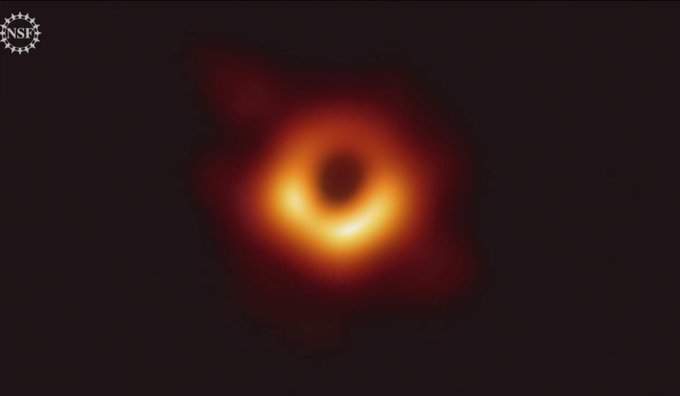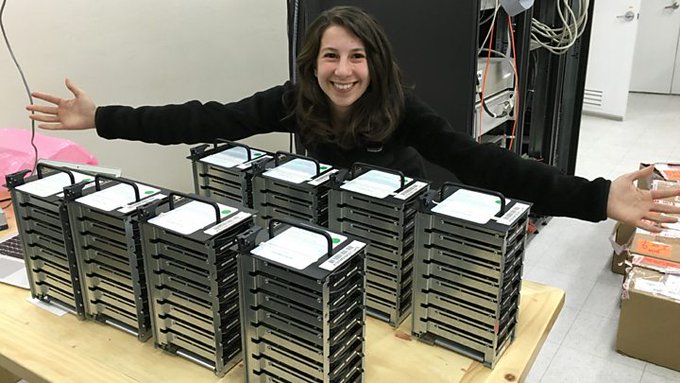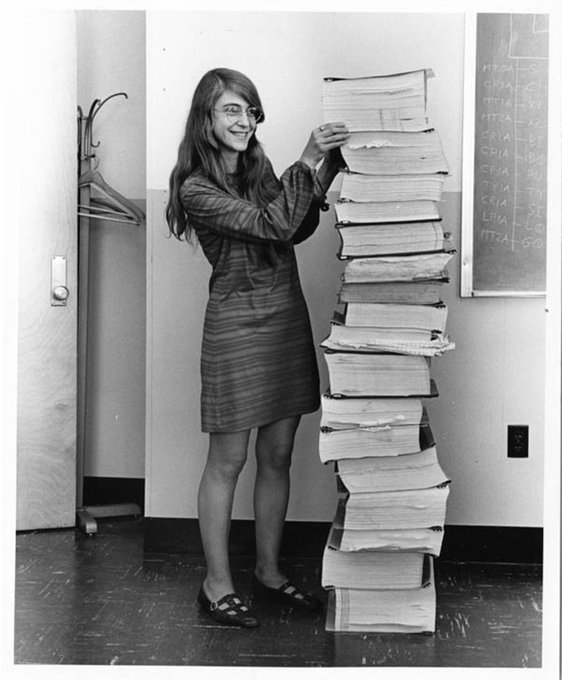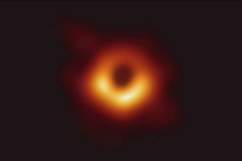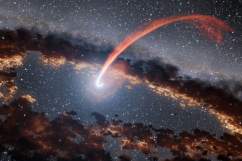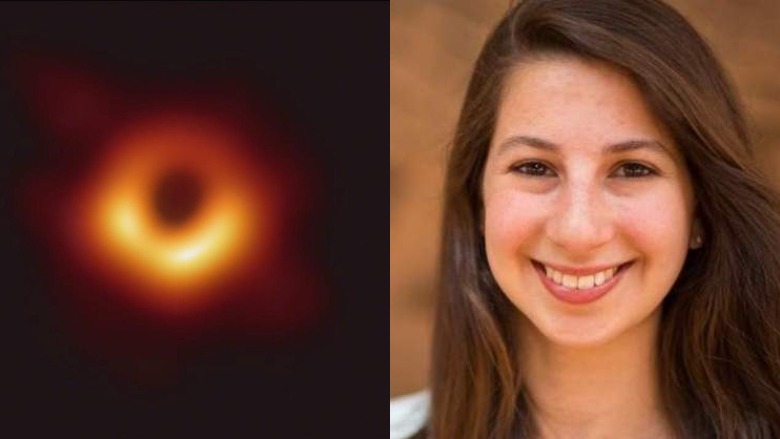
Katie Bouman, 29, is the researcher who led the creation of an algorithm that allowed scientists to capture images of a black hole for the very first time. The National Science Foundation revealed the never-before-seen picture on April 10, 2019.
Bouman was a graduate student at Massachusetts Institute of Technology when she came up with the formula. The team, which strived for several years to take a photograph of a black hole, is called the Event Horizon Telescope Collaboration.
According to CNN, Bouman developed a crucial algorithm that helped devise imaging methods three years ago. That algorithm led to the image of a supermassive black hole at the center of the M87 galaxy. Bouman, working with more than 200 scientists, spent three years directing the verification of images and the selection of image parameters as they took the “sparse and noisy data” from a series of telescopes to make an image, according to CNN.
“We developed ways to generate synthetic data and used different algorithms and tested blindly to see if we can recover an image. We didn’t want to just develop one algorithm. We wanted to develop many different algorithms that all have different assumptions built into them. If all of them recover the same general structure, then that builds your confidence,” Bouman told CNN. “No matter what we did, you would have to bend over backwards crazy to get something that wasn’t this ring.”
“No one of us could’ve done it alone. It came together because of lots of different people from many backgrounds,” Bouman added.
“I’d like to encourage all of you to go out and help push the boundaries of science, even if it may at first seem as mysterious to you as a black hole,” Bouman said in 2016.
Here’s what you need to know.
1. Katie Bouman Has Been Compared on Social Media to Margaret Hamilton, a Fellow MIT Scientist Who Wrote Crucial Software Code for NASA
Katie Bouman’s alma mater made sure to give her plenty of credit for the discovery of the new algorithm that allowed scientists to take a picture of a black hole for the first time in history. The Computer Science & Artificial Intelligence Lab at MIT shared the above photo on social media, showing the black hole and Bouman side by side.
MIT also shared a picture of Bouman standing next to “stacks of hard drives of black hole image data.” They compared Bouman’s creation to the research that enabled astronauts to land on the moon by placing an image of Margaret Hamilton alongside Bouman. Hamilton, who was also an MIT scientist, was credited with writing the crucial software code that allowed NASA to make a mission to the moon possible.
In 2016, while working with a team from the MIT’s Computer Science and Artificial Intelligence Laboratory, the Harvard-Smithsonian Center for Astrophysics and the MIT Haystack Observatory, she told MIT News, “A black hole is very, very far away and very compact. .. (Taking a picture of the black hole in the center of the Milky Way galaxy is) equivalent to taking an image of a grapefruit on the moon, but with a radio telescope. To image something this small means that we would need a telescope with a 10,000-kilometer diameter, which is not practical, because the diameter of the Earth is not even 13,000 kilometers.”
According to the MIT News story, the algorithm Bouman helped create would stitch data together collected from radio telescopes across the Earth, creating a “large radio telescope dish.”
2. Bouman Posted a Photo of Her Immediate Reaction — ‘Disbelief’ — After Seeing the Image of the Black Hole For the First Time
Katie Bouman appears to keep her social media profiles very private. But the picture of her reacting to seeing the black hole picture for the first time was made public on her Facebook page.
Bouman posted a picture of herself with her hands up to her mouth with the black hole image on her computer screen in the background. She wrote in the caption, “Watching in disbelief as the first image I ever made of a black hole was in the process of being reconstructed.”
In an interview with Nature Video, Bouman said, “This is just the beginning of being able to have another window into what black holes can tell us about our laws and physics. But already we’ve learned so much. Even though we had predicted that if you had a black hole you would see this ring of light, but we didn’t know we were going to get that ring of light. And that is what we were kind of testing. We could have gotten just a blob. So seeing that ring, and seeing a ring that has a size that is consistent with other measurements that have been done completely independetly, I think that in itself, just being able to see that ring of light, being able to see that ring exists, is huge.”
Vincent Fish, a research scientist at MIT’s Haystack Observatory, told CNN, “(Bouman) was a major part of one of the imaging subteams. One of the insights Katie brought to our imaging group is that there are natural images. Just think about the photos you take with your camera phone — they have certain properties. … If you know what one pixel is, you have a good guess as to what the pixel is next to it.”
Bouman later posted a photo with several of the team members she collaborated with on the mission to document a black hole. She wrote on Facebook, “I’m so excited that we finally get to share what we have been working on for the past year! The image shown today is the combination of images produced by multiple methods. No one algorithm or person made this image, it required the amazing talent of a team of scientists from around the globe and years of hard work to develop the instrument, data processing, imaging methods, and analysis techniques that were necessary to pull off this seemingly impossible feat. It has been truly an honor, and I am so lucky to have had the opportunity to work with you all.”
Her father, Charles Bouman, an engineering professor at Purdue University, told the Journal & Courier his daughter had told her family a big announcement would be coming on Wednesday, but said she couldn’t provide details.
“But she wasn’t allowed to tell us what it was, exactly, though we sort of guessed that it had to be the first image. She kept it absolutely secret, even from her parents,” her proud father told the local newspaper after the photo was revealed. He said it was exciting for him as a parent and a researcher, because his daughter brought people together, “in interdisciplinary work, which is hugely challenging.”
He told the newspaper, “But also, technically, this is sort of a field of essential interest for me, in my own research. Although I would say she took a much bigger step. … I see this as a giant step, because it’s an example of what I’d call a breakthrough result. It’s really bringing what we call machine learning and artificial intelligence to scientific discovery.”
3. Bouman, Who Studied Electrical Engineering at MIT, Gave a Ted Talk About ‘How to Take a Picture of a Black Hole’
This was a moment nearly three years in the making. Katie Bouman led the development of the algorithm in 2016 while she was a graduate student at MIT, studying electrical engineering and computer science. She collaborated with the Harvard-Smithsonian Center for Astrophysics, and the MIT Haystack Observatory to finalize the formula.
Bouman titled the algorithm “Continuous High-resolution Image Reconstruction using Patch priors.” She explained to MIT News at the time that trying to take a picture of a black hole is comparable to “taking an image of a grapefruit on the moon, but with a radio telescope. To image something this small means that we would need a telescope with a 10,000-kilometer diameter, which is not practical, because the diameter of the Earth is not even 13,000 kilometers.”
To get around this challenge, Bouman’s algorithm does not rely on a single telescope. Instead, it pieces together data from radio telescopes around the globe. The Event Horizon Telescope was the team that collaborated to put all of the data together.
In November 2016, Bouman gave a Ted Talk at TedxBeaconStreet about her work, titled “How to take a picture of a black hole.” You can watch her talk below:
“Different types of images have very distinct features. We can easily tell the difference between black hole simulation images and images we take every day here on Earth. We need a way to tell our algorithms what images look like without imposing one type of image’s features too much. One way we can try to get around this is by imposing the features of different kinds of images and seeing how the type of image we assume affects our reconstructions. If all images’ types produce a very similar-looking image, then we can start to become more confident that the image assumptions we’re making are not biasing this picture that much,” she said during the talk.
Bouman added, “This is a little bit like giving the same description to three different sketch artists from all around the world. If they all produce a very similar-looking face, then we can start to become confident that they’re not imposing their own cultural biases on the drawings. One way we can try to impose different image features is by using pieces of existing images. So we take a large collection of images, and we break them down into their little image patches. We then can treat each image patch a little bit like pieces of a puzzle. And we use commonly seen puzzle pieces to piece together an image that also fits our telescope measurements.”
4. She Has a Ph.D. in Electrical Engineering & Is Currently a Professor at the California Institute of Technology in Pasadena
Katie Bouman’s college education began at the University of Michigan. She earned an undergraduate degree in Electrical Engineering in 2011.
Bouman headed to Cambridge, Massachusetts after that. She earned a master’s degree in Electrical Engineering and Computer Science in 2013 from the Massachusetts Institute of Technology. Bouman stayed at MIT for her Ph.D., which she obtained in 2017.
As referenced above, Bouman began collaborating with the Event Horizon Telescope while she was still a student. She stayed on as a postdoctoral fellow after earning her doctorate degree.
Bouman is now teaching. She accepted a Visiting Associate position in the Computing and Mathematical Sciences department at the California Institute of Technology in Pasadena. Her research focus is described on the Caltech website as “designing systems that tightly integrate algorithm and sensor design, making it possible to observe phenomena previously difficult or impossible to measure with traditional approaches.”
5. Bouman, a West Lafayette, Indiana, Native, Who Was Doing Research at Purdue While Still in High School, Is a Newlywed
Katherine L. Bouman recently had reason to celebrate in her personal life as well. She is a newlywed.
According to her profile on TheKnot.com, Bouman married Joe Leong on September 2, 2018, in Michigan. Her cover photo on Facebook displays her wedding dress.
Bouman was born on May 9, 1989, according to a search of online records. Bouman is originally from West Lafayette, Indiana. She graduated from West Lafayette High School in 2007, according to the Journal & Courier. She is the daughter of Charles Bouman and Cristina Bouman and has one sister, Amanda Bouman.
Her father, Charles Bouman, told the Journal & Courier that his daughter was doing imaging research at Purdue University in her hometown while she was still in high school. Her high school teacher, Phil Pusey, told the newspaper he was thrilled for her success.
“She was a super-detailed kind of kid, even when I had her in class. She was always ordered and organized, lab notes were written out to super-detail. … I can’t wait to show my kids in class. That’s really cool,” Pusey said.
